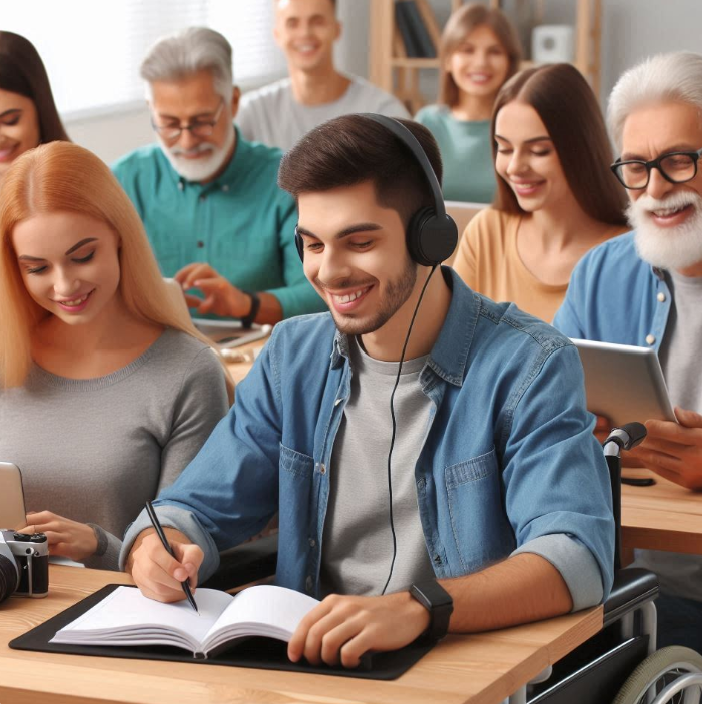It was very interesting to listen to Valerie’s Interview with Charlie Watson from the UVic center for Accessible Learning. I had no idea that there were so many ways to create accessibility.
Charlie mentioned two things that really resonated with me:
- He said that accessibility requires that our systems accept people, instead of people accepting our systems. I really thought about this from an EAL teacher’s point of view. Though my coworkers and I do try to adapt and rework materials and lessons to suit our students’ abilities and backgrounds, we often still get frustrated when our newcomers don’t conform to our ways. We try to get them to accept our school and cultural structure and the phrase when in Rome is often heard when a teacher is trying to get one of our traditional systems to work. Examples that come to mind are cheating on tests, arriving late to class and interrupting when others are speaking. Though these examples are not ones of technology, I still think instructors for newcomers need to think about our systems becoming more accepting.
- Charlie then said that ability is temporary and that one day each of us will be disabled and will benefit from accessible design. I used to have great eyesight in my younger years, but during COVID with the increased screentime required (my coworkers and I taught online for a year and a half as adults were more vulnerable and the district waited for the vaccines) my eyesight declined significantly. I needed stronger glasses, I needed to enlarge the screen, and I realized that I was at a time in my life when decline would slowly make itself known. As someone who lived abroad in Japan for 4 years, before smartphones could help to translate everything, I also recognize how it feels to benefit from accessible design. Japan’s restaurants are famous for their menus that have pictures of all the dishes or their plastic food displays. Before I learned enough of the language, I frequently pointed and nodded to order. Check out my blog post from EDCI 565 – Learning in Japan Then and Now if you are interested in how learning Japanese has changed over the years.

Charlie also mentioned the POUR principles or framework which I was only a little familiar with. I found this video helpful in understanding the acronym: perceivable, operable, understandable, robust.
How can the POUR framework be used when teaching adult newcomer ELLs?
Perceivable: Materials and resources can be designed so that all learners can perceive the content, regardless of their language proficiency or sensory abilities. For example, providing visual aids, subtitles, or alternative text for images can help ELLs better understand the material.
Operable: Resources should be easy to navigate and use, even for those who may not be familiar with digital tools. Simple interfaces and clear instructions can empower ELLs to engage with learning materials independently.
Understandable: Content should be presented in a way that is easy to comprehend, with clear language and culturally relevant examples. This ensures that ELLs can grasp the concepts being taught without unnecessary confusion.
Robust: Resources should be compatible with a variety of devices and platforms, ensuring that ELLs can access them regardless of the technology they have available.
By keeping the POUR framework in mind, educators can create inclusive learning environments that address the unique needs of adult newcomer ELLs, helping them build language skills and confidence in their new surroundings.
What other assistive tech/adaptive tech is best for newcomers or adult learners?
Assistive and adaptive technologies can be incredibly helpful for newcomers or adult learners, especially when tailored to their specific needs. A few ideas:
- Translation Apps: can be used to understand difficult text or speech or to communicate something
- Speech-to-Text Software: can be used if the student is stronger in speaking than writing or wants to practice pronunciation to see if the device recognizes their meaning
- Text-to-Speech Tools: can be used if the student is stronger in writing and needs to hear the pronunciation
- Digital Note-Taking Apps: can be used by younger students who may prefer digital to pen and paper
- Screen Readers: can assist ELLs who have difficulty reading but if they hear the text read, will understand more
- Magnification Software: to assist those with visual impairments
- Hearing Assistance: to assist those with hearing impairments
- Audio Books: similar to screen readers, to hear the language and read along, to hear the pronunciation – I have used audio books chapter by chapter, reading first and then listening as a review
These are only a few tools that can empower adult learners and newcomers to overcome barriers and thrive in their learning journeys. Just as my learning experience in Japan was very different from the learning experience someone would have today, the accessibility and learning devices will continue to change and become more helpful to those who need them. As Charlie said – we will all one day find ourselves in need of accessible design.


Recent Comments